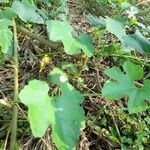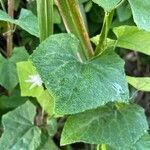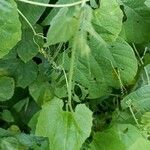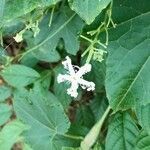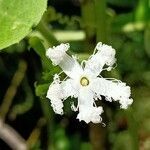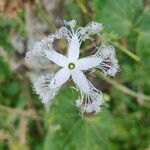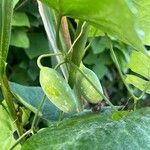Climber, 5-8 m long, with sparse (dense) minute hairs, partly glabrescent, leafy stem 1.5-2(-5) mm diam.; monoecious. Probract absent. Tendrils 2-(or 3-)branched. Leaves: petiole 2-12 cm long; blade green on drying, membranous, simple, unlobed, or shallowly or deeply 3-7-angular or-lobed, 2/3 deep, in outline subcircular, or broadly reniform, 5-12(-20) by 9-12(-25) cm, finely hairy, sometimes faintly scabrous, without or with few scattered minute glands, cystoliths not obvious, margin entire or sparsely shallowly dentate-undulate; veins 3(-5). Male raceme sometimes with co-axillary a solitary male flower or a solitary female flower (the female flower developing before the male raceme), hairy or glabrescent; peduncle 5-15 cm long, 1(-2) mm thick; rachis not thickened, 3-10 cm long, 5-10 (or more)-flowered; bracts subpersistent or caducous, elliptic, 0.5-2 mm long, margin (sub)entire, glands absent. Male flowers: pedicel 5-20 mm long, persistent; receptacle-tube 15-20 mm long, at throat 3-4(-5) mm wide; sepals linear, 2-3 mm long, c. 1 mm wide at base, entire; petals (narrowly) ovate, 6-10 mm long, threads c. 10 mm long; synandrium 2-3 mm long, filaments short. Female flowers: pedicel 5-12 mm long or longer; ovary hairy, (narrowly) ellipsoid, 3-10(-30) mm long. Fruit ripening bright orange, paler speckled or striped, ellipsoid or long-cylindrical, 2.5-5(-150) by 1.5-4 cm, apex beaked; exocarp (thinly) leathery, smooth; pericarp ± juicy, dry pericarp 3-5 mm thick; pulp orange, not fibrous, slightly bitter; fruiting pedicel 1-2 cm long, 2 mm thick. Seeds pale or dark brown, compressed, (narrowly) elliptic, 6-18 by 4-9 by 2.5-3.5 mm, margin broad, distinct or faint, edge undulate.
More
Plants annual. Stems slender, profusely branched, ± pubescent. Leaf blade reniform or broadly ovate, (5-)7-10 × 8-11 cm, membranous, ± deeply 5-7-lobed; lobes triangular or rhombic. Plants monoecious. Male peduncles in pairs, earlier 1-flowered, later bearing a raceme; raceme few flowered; peduncle slender, 15-20 cm, puberulent; pedicel erect, 0.5-1.5 cm, puberulent; bracts absent or very small; calyx tube somewhat dilated at apex, 15-16 mm. Female flowers solitary or sometimes replacing earlier male flower; ovary oblong. Fruit ovoid-oblong, 5-7 × 2.5-3.5 cm, with 7-10 seeds. Seeds ovate-oblong, 9-12 × 5-6 mm, compressed, rugulose, margin thick with toothed projections from both surfaces. Fl and fr. autumn. 2n = 22.
A pumpkin family plant. It is a climber with tendrils. It grows 2.4-6 m high and spreads 1.5-3 m wide. The vine has furrows along it. The leaves have 3 to 7 lobes and a tooth like edge. The flowers are white. The male flowers are without a bract and the female flowers are produced singly. The flowers have long stalks. The long fruit tend to curve. They can be 1-2 m long. When ripe they turn orange or red, but are grey and green when young.
